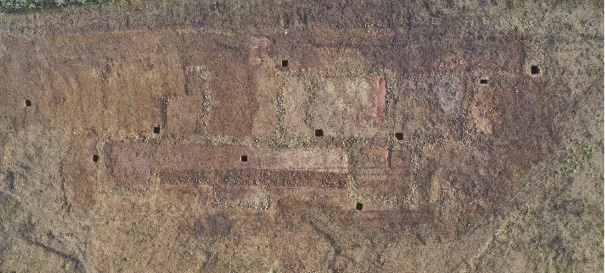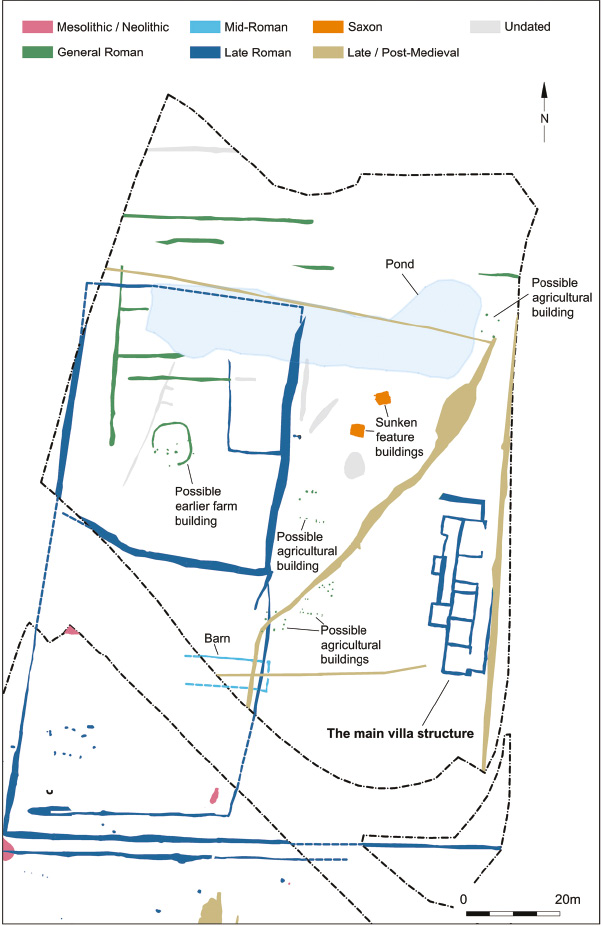Introduction
Evidence of Roman settlement has long been known in the area occupied by the 1950s ‘new town’ of Harlow, Essex. The focus of the Roman town appears to have been its temple complex, set on a low hill alongside the settlement and rising out of the marshland that flanked the adjacent River Stort. While the temple has been extensively investigated, including by Sir Mortimer Wheeler (Wheeler 1928; France and Gobel 1985; Medlycott 2016), the settlement itself remains poorly understood. Much of the development of the new town and its commercial and industrial sectors was completed prior to archaeological investigation of construction sites being a routine undertaking.
More recently, development has been taking place on the eastern periphery of Harlow, providing the opportunity to explore the immediate hinterland surrounding the Roman town. During 2019–22 Archaeology South-East investigated the Newhall Phase 2 development following commission by the RPS Group. This was on behalf of their client Countryside Properties (UK) Ltd. The 2.1 ha of open area excavation produced some particularly interesting results and, although post-excavation analysis is ongoing, some insights into a few of the most significant discoveries can be made. In essence, the recorded remains comprised a Roman villa and part of its landscape (Figure 1). The excavations also encountered the depositing of metalwork in a watery place and evidence of early medieval occupation.
The villa and environs
While hints of Roman buildings had been identified by a preceding trial-trench evaluation, the discovery of the stone foundations of a villa farmhouse was unexpected. While its remains were not fully investigated (the decision being made to preserve in situ within the development), the villa appears to have consisted of around 11 rooms and to have been of a relatively simple corridor type. Its remains were recorded in plan and a number of small test-pits were excavated to gain some insights into its deposit sequence prior to its reburial (Figure 2).
The villa farmhouse evidently faced westwards onto an enclosed yard, within which a natural spring appears to have been utilised to form a large, elongated pond. The yard contained the remains of a barn-like building, along with at least three post-built structures of varying sizes. A sub-circular gully, seemingly situated at the centre of the yard, might represent a further (possibly earlier) building or perhaps the definition of an activity area, such as a haystack, threshing floor or midden. A kiln or hearth was also revealed within the yard and the enclosed farmstead appears to have been surrounded by at least two phases of agricultural fields.
Although few artefacts were recovered from the villa building, deposits in the spring-fed pond produced an array of metal finds. These included knives and tools as well as coins and a rare copper-alloy dodecahedron (Figure 3), of which more below. While their deposition may simply have been the mundane act of rubbish disposal deriving from the villa occupation, further analysis will also explore whether this is the result of deliberate or ritual deposition. Deposition of iron objects in watery contexts is a well-documented phenomenon during the Iron Age and Roman periods (Manning 1972; Hingley 2006); however, it has been speculated that ritual or votive deposition in watery contexts may be no more than casual superstition (Cousins 2014).
The Newhall villa is located approximately 1.5 km southeast of the known extent of the Roman town and appears to have been one of a number of villa residences occupying its immediate hinterland. Following the villa’s demise, the site may have continued as a focus of activity into the early medieval period when two distinctive sunken-featured buildings of fifth- to seventh-century date were constructed in its vicinity. Five further sunken-featured buildings have been discovered elsewhere within the Newhall development, though situated further north and south, which cumulatively indicate the presence of unenclosed, dispersed settlement across this landscape. While these early medieval buildings appear to have actively avoided the villa itself, it seems that the remnants of the surrounding managed Roman farmscape were attractive to resettlement. Post-excavation analysis of the Newhall site therefore has some potential to contribute to debates surrounding Late Roman to early medieval settlement continuity, abandonment and resettlement (Millett 1990; Cleary 2011). The Roman villa at Rivenhall, Essex, showed signs of Anglo-Saxon occupation within the villa barn (Rodwell et al. 1973) and it is possible that similar occupation occurred at Harlow. Despite the dispersed nature of the Newhall early medieval remains, the two sunken feature buildings encountered during the 2019 phase of works appear to respect the main villa structure.
The dodecahedron
Roman dodecahedrons are a rare and enigmatic type of archaeological artefact, to which many postulated uses have been ascribed – some entirely plausible, some somewhat outlandish, but all unproven. Cast-made, of either copper alloy or else iron, these 12-sided objects all feature a central aperture in each face – often of varying diameter – commonly surrounded by concentric rings, with each corner featuring a protruding knob. The Newhall dodecahedron is a largely complete and well-preserved example, measuring 50 mm in height.
Suggested functions for these artefacts include astronomical, land survey or ballistic distance measuring devices, though more mundane explanations such as candlesticks, dice and glove-making tools have also been advanced (Hill 1994; Thompson 2011; Guggenberger 2013). To date no more than 150 examples of dodecahedra have been recorded. They are widely dispersed across the north-west of the Roman empire, from Wales in the west to Hungary in the east and from Germany in the north to the south of France. Perhaps most notably, these relatively well-crafted and probably relatively high-status or high-value objects are most commonly found at military forts and coloniae settlements, or else at high-status rural residences such as villas (though also at temple sites, in metalwork hoards and graves). As such, this example is not out of place at Newhall, although it is one of only a small number of dodecahedrons for which the precise burial context is known; its excavated context provides little evidence to help solve the conundrum of its function.
Declarations and conflicts of interest
Research ethics statement
Not applicable to this article.
Consent for publication statement
Not applicable to this article.
Conflicts of interest statement
The author declares no conflicts of interest with this article. All efforts to sufficiently anonymise the author during peer review of this article have been made. The author declares no further conflicts with this article.
References
Cleary, SE. (2011). The ending(s) of Roman Britain In: The Oxford Handbook of Anglo-Saxon Archaeology. Hamerow, H, Hinton, DA; DA and Crawford, S S (eds.), : 13–29. Oxford: Oxford University Press.
Cousins, EH. (2014). Votive objects and ritual practice at the King’s Spring at Bath In: TRAC 2013: Proceedings of the Twenty-Third Annual Theoretical Roman Archaeology Conference, King’s College, London 2013. Platts, H, Pearce, J; J and Barron, C; C, Lundock, J; J, Yoo, J J (eds.), : 52. Oxford: Oxbow Books.
France, NE; Gobel, BM. (1985). The Romano-British Temple at Harlow. Harlow: West Essex Archaeological Group.
Guggenberger, M. (2013). The Gallo-Roman Dodecahedron. The Mathematical Intelligencer 35 : 56–60, DOI: http://dx.doi.org/10.1007/s00283-013-9403-7
Hill, C. (1994). Gallo-Roman dodecahedra: A progress report. Antiquaries Journal 74 : 289–292, DOI: http://dx.doi.org/10.1017/S0003581500024458
Hingley, R. (2006). The deposition of iron objects in Britain during the later prehistoric and Roman periods: Contextual analysis and the significance of iron. Britannia 37 : 213–257, DOI: http://dx.doi.org/10.3815/000000006784016620
Manning, WH. (1972). Ironwork hoards in Iron Age and Roman Britain. Britannia 3 : 224–250, DOI: http://dx.doi.org/10.2307/526028
Medlycott, M. (2016). Harlow Temple: Bartlett excavation archive, ADS collection no. 2418. DOI: http://dx.doi.org/10.5284/1040799
Millett, M. (1990). The Romanisation of Britain: An essay in archaeological interpretation. Cambridge: Cambridge University Press.
Rodwell, W; Rodwell, K; Evison, VI. (1973). The Roman villa at Rivenhall, Essex: An interim report. Britannia 4 : 115–127, DOI: http://dx.doi.org/10.2307/525860
Thompson, FH. (2011). Dodecahedrons again. Antiquaries Journal 74 : 289–292, DOI: http://dx.doi.org/10.1017/S0003581500063484
Wheeler, REM. (1928). A “Romano-Celtic” temple near Harlow, Essex, and a note on the type. Antiquaries Journal 8 : 300–326, DOI: http://dx.doi.org/10.1017/S0003581500012269



